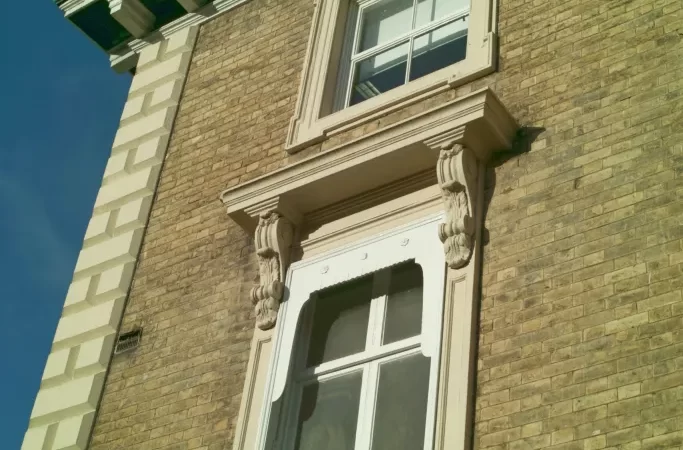Sash windows have been an integral part of London’s architecture since the late 17th century. Early sash windows were made of oak, with small panes of glass separated by wooden glazing bars. As glass making techniques advanced in the 18th century, the individual panes became larger, and the windows increased in height to allow more
Sash windows have been an integral part of London’s architecture since the late 17th century. Early sash windows were made of oak, with small panes of glass separated by wooden glazing bars.
As glass making techniques advanced in the 18th century, the individual panes became larger, and the windows increased in height to allow more light into buildings.
The practicality and elegance of the sash window led to its prolific use during the Georgian period as London expanded rapidly. Terraces were built featuring sash windows to give an air of grandeur.
Refinements for Enhanced Functionality
Londonbooksash noted that over time, sash window designs were refined for smoother operation. The addition of horns to hold the weight of the glass and concealed pulley systems with spiral balances enabled the windows to be opened and closed more effortlessly. Decorative astragal glazing bars created beautiful symmetrical facades, while the frames evolved from timber to hardwearing metals like steel and bronze.
Georgian Architecture Showcases Sash Windows
Some of London’s most prestigious Georgian streets, such as the grand terraces of Fitzroy Square and Bloomsbury, are renowned for their period architecture complete with original sash windows. The windows beautifully illuminate the clean classical lines of the buildings, seamlessly integrating into the elegant facades. Georgian sash windows came to represent the very pinnacle of subtle grace and functionality.
Sash Windows in Rustic Settings
While sash windows are synonymous with stately Georgian homes, they are equally at home in more rustic settings. Older village houses, country pubs and rectories across London display generations of sash windows, their wavy glass and worn sash cords adding authenticity. Industrial heritage buildings like old factories and warehouses often feature casing iron sash windows, now framing modern loft apartments.
The Wider Heritage of British Sash Windows
Beyond London, sash windows are a familiar sight in period properties across the UK, demonstrating how popular they became. However, London’s vast number of surviving historic sash windows cement its status as an unmatched showcase of this heritage. Wandering the city’s Georgian squares, the glinting windowpanes evoke a sense of bygone eras.
Threats to London’s Sash Windows
The enduring presence of so many sash windows provide a vital link between the past and present. However, thoughtless replacement with modern aluminium frames has damaged architectural heritage. As original windows get discarded, London’s history is eroded. Fortunately, heritage groups highlight the need to preserve traditional windows and many homeowners now recognise their significance.
The Resurgence of Sash Window Restoration
This growing awareness has led to a resurgence of specialist sash window firms dedicated to repair and restoration using traditional techniques. Where restoration is impossible, reputable companies ensure replacement windows match the original aesthetics. Modern double glazing can also be inserted into existing frames to improve energy efficiency. Expert restoration and draught-proofing prolong the lifespan of historic sash windows.
Preserving Windows Preserves London’s Value
London’s iconic sash windows are valued architectural assets, enhancing the city’s financial and cultural worth. Their continued survival brings benefits to heritage, residents, and visitors alike. Though originating centuries ago, they remain integral to the charm of London’s historic streets. Beyond aesthetics, they represent the richness of craftsmanship through the ages.
The Craft of Sash Window Restoration
Expert sash window restoration is itself an art form, requiring meticulous traditional craftsmanship. Specialist firms possess extensive carpentry skills refined over many years of working with historic windows. The restoration process begins with a careful inspection to assess the window’s condition. Existing paint and putty are removed before any rotten wood or broken panes are repaired or replaced.
The weight pockets and pulley mechanisms must be cleaned out and repaired to restore smooth operation. Historically-accurate materials are used, including linseed-oil based putty and traditional paints. The sash cords may be replaced with appropriate lengths to ensure correct counterbalancing. Draught-proofing is added using slender brass strips or modern materials like weather pile concealed behind existing beading.
Where glass is missing, restoration experts can recreate period glass with undulations, bubbles, and imperfections characteristic of early glass-making. If entire sash boxes are beyond repair, they will replace them with meticulously crafted replicas. The very best sash window restorers have such attention to detail that restored windows look indistinguishable from the originals. Their work preserves both functionality and authentic charm.
Promoting Sash Window Heritage Through Training
A vital parallel to the physical restoration of London’s sash windows is passing on the necessary skills and knowledge. Training new generations of specialists ensures traditional techniques endure to keep this heritage alive. bodies like Historic England, industry organisations and experienced firms provide training courses.
Recruiting apprentices is key, enabling extended learning under a master craftsman. Surveying and evaluating historic windows are taught alongside practical restoration skills like joinery, applying putty and cutting glass. Specialist tools like sash window planes are introduced. Draught-proofing, repairing, and replacing sash boxes or cords also feature. Equal focus is given to understanding heritage value and architecture.
Field visits allow first-hand experience of eighteenth-century windows. Current specialists take pride passing on expertise they have spent decades accumulating. In an age of relentless modernisation, training people to restore original sash windows is crucial cultural preservation. The more practitioners appreciate their irreplaceable heritage, the more our built history benefits. Sash window restoration training keeps vital craft skills alive.
Final words
When you wander past elegant Georgian squares or see iron-framed windows in old warehouses, take a moment to appreciate London’s sash window heritage. These windows are functional relics of the past, carefully preserved and repurposed for future generations. They connect present day Londoners with the city’s architectural history in a tangible, enlightening way.



















Leave a Comment
Your email address will not be published. Required fields are marked with *